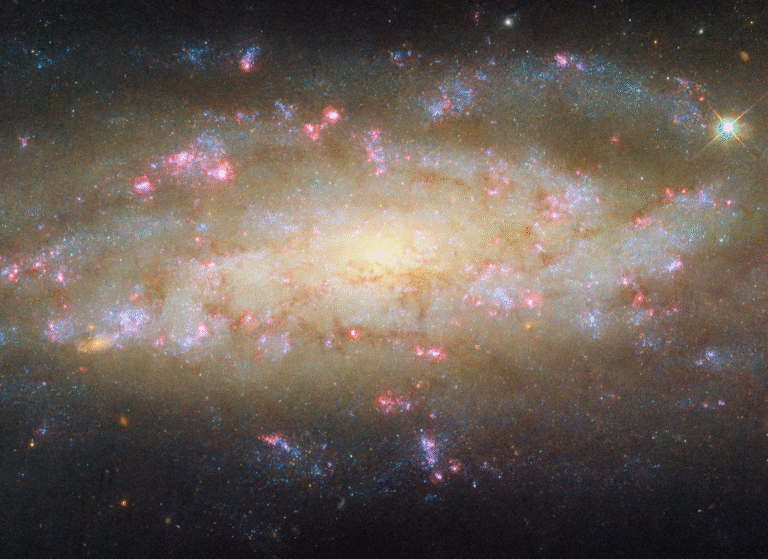Solar Orbiter Offers the First Clear Look at the Sun’s Mysterious Polar Magnetic Field in Motion

For the first time in history, scientists have managed to observe the Sun’s polar magnetic field in motion—a major step forward in understanding how our star’s mysterious 11-year cycle works. Thanks to ESA and NASA’s Solar Orbiter spacecraft, researchers have now obtained detailed data from the Sun’s south pole, revealing dynamic plasma flows and magnetic field movements that could reshape our understanding of solar activity.
The Sun’s Rhythmic Magnetic Cycle
The Sun isn’t just a giant ball of burning gas—it follows a strict magnetic rhythm. Roughly every 11 years, the Sun’s magnetic field reverses polarity, leading to what scientists call the solar cycle. This cycle governs solar activity, including the formation of sunspots, solar flares, and coronal mass ejections—phenomena that can affect space weather and even satellites orbiting Earth.
At the heart of this cycle lies a vast magnetic conveyor belt—a continuous flow of plasma that carries magnetic field lines from the equator toward the poles on the surface, and then back toward the equator deep inside the Sun. This motion sets the pace for the magnetic flip that defines each new solar cycle.
However, while this model has been known for decades, there has always been one big mystery: what actually happens at the Sun’s poles? Until now, even the most advanced telescopes from Earth and space missions orbiting in the plane of the planets could only get a limited, sideways glimpse of these regions.
A Spacecraft That Finally Looks Over the Edge
That’s where Solar Orbiter comes in. Launched in February 2020 by the European Space Agency (ESA) with strong support from NASA, the spacecraft was designed to take the closest and most detailed look at the Sun ever attempted. By 2025, it achieved something no other mission had done before—it moved into a tilted orbit, 17 degrees above the ecliptic plane, giving it a direct view of the Sun’s south pole.
In March 2025, Solar Orbiter used two key instruments to gather a rich dataset:
- The Polarimetric and Helioseismic Imager (PHI), which measures magnetic fields and plasma movements on the Sun’s surface.
- The Extreme Ultraviolet Imager (EUI), which captures high-resolution images of the Sun’s upper atmosphere, the chromosphere.
Between March 16 and March 24, EUI collected continuous images of the Sun’s southern polar region, while PHI recorded precise magnetic data on March 21. The result? The first detailed motion map of the magnetic field near the Sun’s south pole.
Supergranules: The Building Blocks of Solar Motion
The Solar Orbiter’s data revealed a refined view of the Sun’s supergranulation pattern—a network of enormous plasma cells, each roughly two to three times the size of Earth. These hot plasma bubbles rise and fall on the solar surface, creating horizontal flows that push magnetic field lines toward the edges of the cells. Over time, this action weaves the Sun’s magnetic network—a web of intense magnetic fields that cover the entire solar surface.
What the researchers found at the south pole was surprising: the magnetic field lines were drifting toward the pole at speeds of around 10 to 20 meters per second (roughly 36 to 72 kilometers per hour). This was significantly faster than what earlier Earth-based observations had estimated.
Why This Finding Is So Surprising
Previous studies—based on indirect measurements from the ecliptic plane—suggested that magnetic field motion slows down near the poles. But Solar Orbiter’s data tells a different story. It shows that even at the highest latitudes, the plasma flow continues moving briskly toward the poles.
This discovery challenges long-held assumptions about how the Sun’s global circulation behaves. It implies that the magnetic conveyor belt might not slow down near the poles at all, as most solar models have predicted for decades.
According to the scientists behind the research, this movement of supergranules acts like a tracer, letting us “see” the Sun’s hidden polar component of its global flow for the first time. It’s as if we’ve finally found a missing piece of the puzzle—something that helps us connect what happens near the equator with the unseen processes near the poles.
The Bigger Picture: Why the Poles Matter
Understanding the Sun’s poles is crucial for predicting solar activity. The poles store the magnetic “seeds” that eventually form sunspots and drive solar storms. When the magnetic fields at the poles flip, a new solar cycle begins.
If the poleward flow is faster than we thought, it might mean that the Sun’s magnetic field reverses sooner or that upcoming solar cycles will behave differently than expected. These insights could help scientists refine their predictions about future solar maxima and minima, which are essential for space weather forecasting.
Space weather may sound distant, but it directly affects us—satellite communications, GPS systems, and even power grids on Earth can be disrupted by strong solar storms. Knowing how magnetic energy builds up and moves inside the Sun helps us prepare better for such events.
A Glimpse Into the Data
The data analyzed in this study came from two instruments:
- PHI (Polarimetric and Helioseismic Imager) provided measurements of magnetic field directions and plasma flows on March 21, 2025.
- EUI (Extreme Ultraviolet Imager) captured images between March 16 and March 24, 2025, showing bright spots that represent magnetic concentrations in the chromosphere.
By combining these two sets, the researchers were able to map how the magnetic network moves over time. They processed eight days of observations into a single image, revealing bright arcs—tracks of magnetic regions moving with the Sun’s rotation.
These images offered the first real-time view of polar supergranulation and magnetic field drift, giving researchers a direct look at the forces shaping the solar magnetic cycle.
What Comes Next for Solar Orbiter
While this discovery is groundbreaking, it’s just a snapshot—a brief glimpse of one moment in the Sun’s 11-year rhythm. The data represents only eight days of observations and covers only the southern hemisphere.
Solar Orbiter’s orbit will gradually tilt even more in the coming years, eventually providing a better view of both poles. When that happens, scientists will be able to track these flows over longer periods, compare north and south polar behavior, and confirm whether this fast motion is consistent across the solar cycle.
The next step will be to integrate these results into models of the solar dynamo, the process by which the Sun generates its magnetic field. If the polar flows remain strong even near the poles, this could reshape our entire understanding of how solar cycles operate.
Understanding the Magnetic Conveyor Belt
The solar magnetic conveyor belt is a key mechanism in solar physics. Near the surface, plasma flows from the equator toward the poles, carrying magnetic field lines with it. Deeper inside the Sun, plasma returns toward the equator, completing a massive loop that spans the entire solar hemisphere.
This process drives the Sun’s magnetic evolution and determines when and how the magnetic poles flip. The discovery that this conveyor belt may move faster at the poles than previously believed hints that the Sun’s internal engine could be more efficient and dynamic than models currently assume.
This could also affect how strong or weak upcoming solar cycles become. A faster conveyor might lead to quicker magnetic field reversals or more energetic cycles—both of which have major implications for space weather prediction.
Why This Discovery Is a Big Deal
This finding doesn’t just fill a gap—it transforms how scientists visualize the Sun’s internal motion. Until now, the polar regions were largely a blind spot in solar observations. With Solar Orbiter’s new vantage point, researchers finally have direct evidence of magnetic field migration near the poles.
It’s a reminder of how much we still don’t know about our nearest star. Every new image and dataset from Solar Orbiter brings us closer to understanding the forces that drive everything from the Northern Lights to solar flares that can knock out satellites.
As Solar Orbiter continues its mission, we can expect more revelations—possibly even real-time tracking of the next solar magnetic reversal, which could happen within the next few years.
Research Reference:
Supergranulation and Poleward Migration of the Magnetic Field at High Latitudes of the Sun – L. P. Chitta et al., The Astrophysical Journal Letters (2025)





